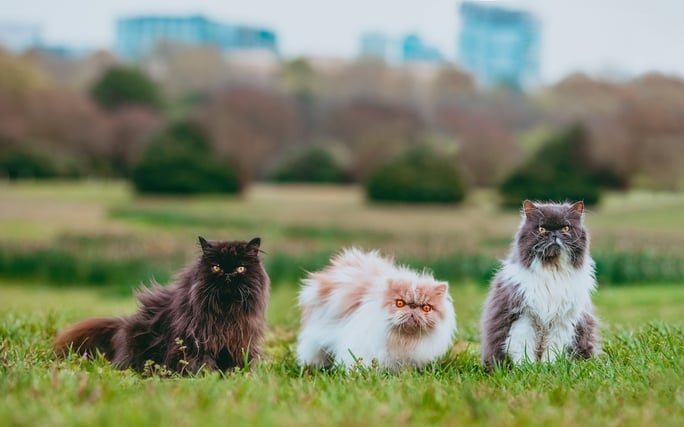What Travel Conditions are Stressful for My Flat-Faced Cat?
Published on: August 22, 2023 | Author: Starwood Pet Travel

Pet owners and animal enthusiasts are starting to realize that while flat-faced (aka brachycephalic) pets may be adorable, they also come with significant health concerns, particularly related to breathing. Travel can exacerbate these issues, especially for cats, making it even more important to understand the stress it can cause. This understanding will help you make informed decisions about whether or not to bring your cat along on your travels, and if so, how to ensure a positive experience for them. Exampled of flat-faced or brachycephalic cats include British Shorthair, Exotic Shorthair, Selkirk Rex, Persian, Scottish Fold, Burmese, Himalayan, and American Shorthair.
If your cat is like most, regardless of whether they have a smushed face or not, they prefer a familiar and predictable environment. Therefore, the idea of travel will immediately put them on edge. It's important to consider that their only travel experiences so far have likely been trips to the vet, which are hardly enjoyable for any feline. In addition to this, there are other travel-related factors that specifically pose challenges for your flat-faced, brachycephalic breed cat.
Travel Environment
If your flat-faced cat is going to be traveling, it is important to consider their unique needs and potential health risks. Flat-faced cats, also known as brachycephalic cats, have difficulty breathing under any conditions, so it is crucial to take extra precautions to ensure their comfort and safety during travel.
When traveling within the United States, it is recommended to look for an airline that allows your flat-faced cat to ride with you in the passenger cabin. Some airlines even allow in-cabin international travel if the flight is relatively short and the destination country does not require pets to arrive as cargo. However, it is essential to first determine whether the airline allows flat-faced cats and dogs to fly at all. Due to the increased risks associated with brachycephalic animals, most airlines have implemented stricter regulations, and some may no longer accept them.
Whether your pet is traveling in the cabin or as cargo, they must be confined in an IATA-approved carrier at all times. It is important to note that sneaking your cat onto your lap for a pet and snooze is not allowed. If your cat is traveling in the cabin, the carrier should fit under the seat in front of you and provide enough room for your cat to move around comfortably. However, if your cat is on the larger side, this may not be suitable for them. Additionally, the cabin can be stuffy, which further increases the risk for your flat-faced cat.
If your cat is allowed to travel as cargo, it is strongly recommended to provide them with a carrier that is roomier than the standard size. (We usually recommend purchasing the next size up). Although all approved kennels are designed to provide maximum ventilation and are sturdy, giving your cat more air space within the confines of their kennel may help them feel calmer and allow them to breathe a little more easily.
Weather
All cats and dogs are at higher risk when traveling in very hot or cold weather, and airlines have strict regulations in place to ensure the safety and well-being of the pets. Flat-faced cats, in particular, face additional challenges during the summer months due to their breathing issues. The heat and humidity can exacerbate their natural breathing problems and put them at a higher risk of heatstroke, which can be deadly.
To prioritize the health and safety of brachycephalic pets, it is recommended that they do not travel if temperatures are above 75 degrees Fahrenheit anywhere along their itinerary. This precaution helps prevent the risk of heatstroke and ensures that the travel experience is as comfortable and stress-free as possible for these special cats.
It's important to note that even airlines that still allow snub-nosed pets to fly may impose embargoes during the summer months. This is done to protect the well-being of these pets and prevent any potential health complications due to the hot weather. Therefore, it's crucial for pet owners to plan their travel accordingly and choose a time of year when the temperatures are more favorable for their flat-faced cats.
Anatomy
In addition to the breathing challenges, some brachycephalic breeds also suffer from other health issues. One common problem is acid reflux, which occurs because these pets cannot eat and digest food properly. The shape of their skull and shortened airways can lead to difficulties in swallowing, causing stomach acid to flow back into the esophagus. This condition can be uncomfortable and painful for the cat, leading to symptoms such as regurgitation, excessive salivation, and discomfort after eating. It is important for pet owners to be aware of this issue and take appropriate measures to manage their cat's diet and feeding habits to alleviate the symptoms of acid reflux.
Furthermore, brachycephalic breeds often have bulging eyes, which are more prone to dry eye and injury. The protrusion of the eyes from the skull leaves them more exposed and vulnerable. Dry eye, also known as keratoconjunctivitis sicca, occurs when the eyes do not produce enough tears to keep them lubricated and moist. This can lead to irritation, redness, and discomfort for the cat. Additionally, the prominent position of the eyes increases the risk of injury, especially during travel when there may be increased commotion and potential hazards. Pet owners should be diligent in monitoring their cat's eye health and seek veterinary attention if they notice any signs of dryness, redness, or injury.
Travel Time
When it comes to traveling with your flat-faced cat, the length of the journey plays a significant role in their overall risk. It is always best to book a direct flight or the shortest possible itinerary to minimize the stress and potential health issues that can arise during travel. However, depending on your destination, layovers may be inevitable.
Layovers can add an extra layer of complexity to the travel experience for your flat-faced cat. Not only does it prolong the overall travel time, but it also exposes your cat to additional stressors such as noise, commotion, and potential mishandling. It's important to keep in mind that while layovers may be unavoidable, they do increase the risk for your cat's well-being.
If you find yourself in a situation where a layover is necessary, there are a few steps you can take to ensure your cat's safety and comfort. First and foremost, research the layover airport to see if they have any pet-friendly facilities or designated areas where your cat can stretch their legs and relieve themselves. This will help minimize the time spent confined in their carrier and provide them with a chance to relax and decompress.
Additionally, during the layover, it's crucial to keep a close eye on your cat's well-being. Make sure they have access to fresh water and a comfortable space to rest. Avoid exposing them to loud noises or crowded areas, as this can increase their anxiety levels. If possible, find a quiet and secluded spot where you can spend some quality time with your cat to reassure them and make them feel safe.
Age and Health
Older cats and overweight cats are at a higher risk for health problems, including travel-related issues. As cats age, their immune systems may weaken, making them more susceptible to illnesses and infections. They may also have underlying health conditions that can be exacerbated by the stress of travel. Additionally, older cats may have difficulty adapting to new environments and routines, which can increase their anxiety levels during travel.
Similarly, overweight cats face additional challenges when it comes to travel. The excess weight puts strain on their joints and can make it harder for them to move around comfortably in a carrier. Obesity also increases the risk of developing respiratory problems, which can be particularly problematic for flat-faced cats who already have breathing difficulties.
When planning to travel with an older or overweight cat, it is important to take extra precautions to ensure their safety and well-being. Before the trip, consult with your veterinarian to assess your cat's health and determine if they are fit to travel. Your vet may recommend specific measures, such as adjusting their diet or providing medication, to help manage any existing health conditions and reduce the risks associated with travel.
During the journey, make sure your cat has access to fresh water and a comfortable space to rest. Consider providing them with extra padding or a soft blanket in their carrier to help alleviate any discomfort caused by their weight or joint issues. It may also be beneficial to schedule regular breaks during the trip to allow your cat to stretch their legs and relieve themselves.
How You Can Help
To ensure a smooth and stress-free travel experience for your flat-faced cat, it is crucial to get them acquainted with their travel crate well in advance. This will give them ample time to explore and become familiar with their new temporary home. Place the crate in a quiet and comfortable area of your home, and make it inviting by adding their favorite blanket or toy inside. Encourage your cat to enter the crate on their own by leaving treats inside, and gradually increase the amount of time they spend inside the crate each day. By doing so, your cat will feel more secure and relaxed in their travel crate when the time comes for the actual journey.
While it may be tempting to consider sedating your cat to keep them calm during travel, it is important to avoid using tranquilizers. Sedatives can have adverse effects on your cat's cognitive and physical abilities, which can increase the risk of anxiety and physical harm. Instead, focus on creating a comfortable and stress-free environment for your cat. Provide them with familiar items, such as their favorite blanket, in their travel crate to help them feel secure. Additionally, consider using calming aids such as pheromone sprays or natural remedies recommended by your veterinarian to help relax your cat during the journey. Remember, it is always best to consult with your vet before using any calming aids or medications.
Hire a Professional
Organizing air travel can be a daunting task, especially when it comes to ensuring the safety and well-being of your beloved pet. This is particularly true for brachycephalic pets, such as flat-faced cats, who have additional challenges and considerations. To navigate through the complexities of air travel with a brachycephalic cat, it is highly recommended to rely on the expertise of pet travel professionals.
By entrusting the logistics of your cat's journey to professionals who specialize in pet travel, you can have peace of mind knowing that every aspect of their travel experience is carefully planned and executed. These professionals have extensive knowledge and experience in handling the unique needs and requirements of brachycephalic pets, ensuring that your cat has the safest, most comfortable, and least stressful journey possible.
Starwood Animal Transport has rebranded to Starwood Pet Travel. We are still the same great company with the best team, just now with a slightly different name.
Subscribe to the Blog
Enjoy our content? Get them sent to your inbox!
Subscribe Now!


